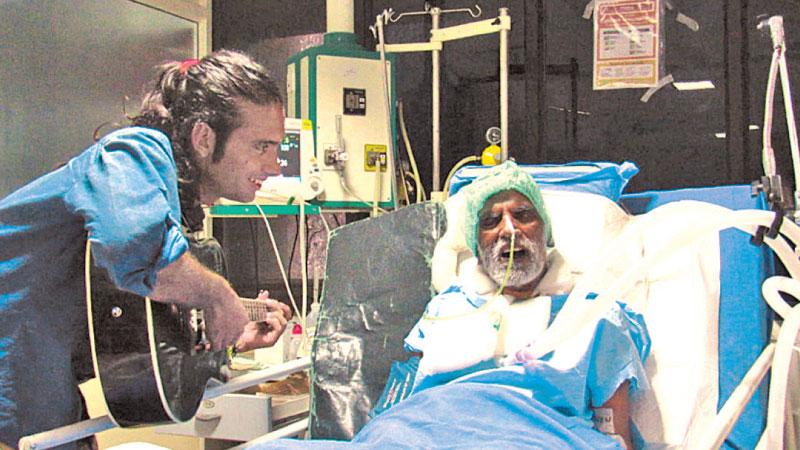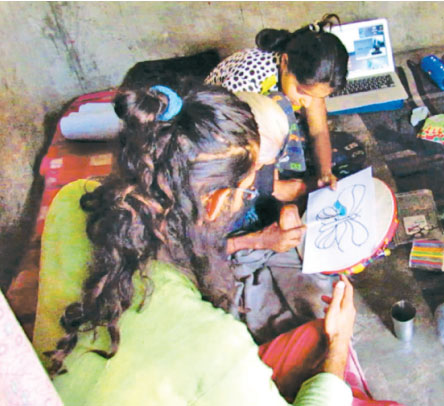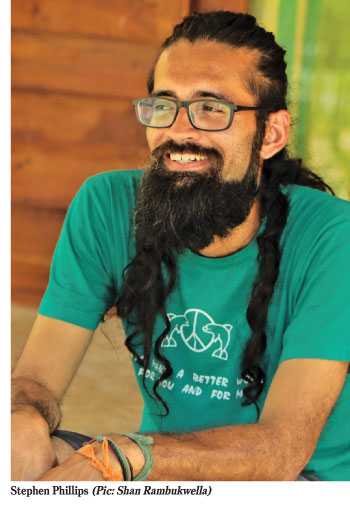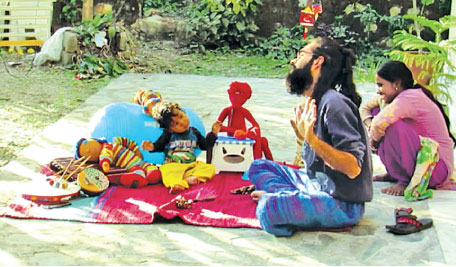
Healing with music is Stephen Phillips’s vocation and passion, a calling which he lives out in the Indian Himalayas. This young man, born and bred in Sri Lanka is now domiciled in Malti, Uttarkashi, in the Indo-Tibetan border state of Uttarkhand.
The lanky, ascetic looking guy with long hair and a top knot lounging on a wooden lounger caught my eye on the beach at Kandakuliya (during Wild Collective Kalpitiya) and soon Keira Perera introduced us. Chatting to him was an extremely interesting experience and made me wish that there were more caring and dedicated people like him. It would certainly make the world a better place.
Music is in Stephen’s genes – his maternal side of the family, the Belings is gifted with musical and artistic talents. In spite of being involved with music in various capacities, the decision to become trained in using music therapeutically was a late one, coming ten years after finishing his schooling at St. Thomas’ Mt. Lavinia. His training in medical music therapy was from the Chennai School of Music Therapy, and the Mahatma Gandhi Medical College and Research Institute, Pondicherry. Later, he broadened his understanding of the subject by studying to be a Sound Healer at Svaram Musical Instruments and Research, Auroville. “My training complimented and confirmed what I had been doing for years – unconsciously and intuitively using music therapeutically,” says Stephen.
Stephen first came to Matli in 2013 on a month’s visit with a group of friends. He did voluntary work in the school and medical camps in the region. He eventually returned in 2015 and taught English in the village school, where he found the use of music to be extremely effective in the teaching of English as a third language. The children loved it but their parents and fellow teachers were often skeptical of Stephen’s methods. “I secretly took much pleasure in their doubts and skepticism” laughs Stephen.
After teaching English for three years Stephen turned full time Music Therapist, and now uses music as medicine and in neurological rehabilitation in his work among people on the Autistic Spectrum, Cerebral Palsy, Asperger’s Syndrome, Rett Syndrome, Muscular Dystrophy, Traumatic Brain Injury, Strokes and Epilepsy. A Music Therapist does not generally diagnose. However, given the socio-economic context he lives in, there is a pervasive lack of awareness with regards to treatment. The sole government hospital in the region and smaller health centres are unequipped to meet these needs, and unusual as it may sound to an urban ear, music is often the sole form of medication amongst most of the people Stephen works with. His patients in general don’t have a proper diagnosis, as the closest neurological care is a good eight hours journey away, and careful observation is his only option when coming to a conclusion with regards to the condition of his patients.
One of his patients is Surinder, a forty year old lady who has a Traumatic Brain Injury after falling off a bike and hitting her head on the ground. She went blind, developed a form of aphasia, (inability to articulate words and confined to making a few sounds) and was paralysed on one side of the body. Matters are also complicated by Surinder being extremely vulnerable and having a brain only partially operated on due to her family’s financial constraints. Working with a vision disabled person who cannot form words, alongside not being proficient in her language was a totally new experience for Stephen. His work with her is a testament to music being a language of its own, proving to be an equally viable form of communication, where words fail. “We are perfectly capable of communicating our intentions and motivations, by adjusting and fine tuning the tone of our voice.” Using a large repertoire of sounds Stephen has found ways to keep the communication constant throughout the sessions he has with her. “Using sounds to communicate may seem primitive, or even bizarre in a civilised society, but this is our foundation, where we all begin. Indigenous communities well know this, and so do mothers. Empowering a baby to make sense of themselves and their surroundings is a strictly non-linguistic process, and mothers are often amongst the most skilled music therapists.” Rhythmic Auditory Stimulation is another of the techniques he uses as a means of helping Surinder. A steady rhythm, serves as an external auditory stimulus, facilitating the rehabilitation of movements to the affected side of her body. Rhythm also guides Surinder to have greater mastery and awareness of her body in relation to her surroundings. From being able to identify the location of small objects like a glass of water in her room, to accurately memorising and mapping the distance from her bed to her door, are all accomplished via rhythm. Bodily functions, including movement are cyclical and rhythmic in nature, and being able to carry out a step by step process to rhythm is an indication of a goal being reached. To empathise with her and put himself in her shoes, Stephen blindfolds himself for two hours a week while going about his daily routine. “It’s one thing to know all the right techniques and jargon, it’s totally another thing to realistically understand what someone else is going through, and even be arrogant enough to expect them to improve, just because you have all the right techniques and suggestions!”
One of Stephen’s favourite stories is from his work with Prince, his two -year -old neighbour, who is on the autistic spectrum. His time with Prince turned out to be a profound experience, with profound results, pushing him far beyond what he understood cognitively, into a place of intuition and a trusting of things to fall into place. When Prince’s parents first brought him to Stephen, he could not maintain eye contact with anyone, nor respond to his name. He showed no signs of being able to form words, and communication was often via spitting and sounds accompanying vehement spitting. Additionally, he showed no sign of being able to walk. The first two months were spent with Stephen music-mirroring Prince, as they sat cross legged facing each other. By mirroring his movement’s and matching the sounds produced, including spitting and spit related sounds, an intimate bond was formed, and within a remarkably short time, Prince began to make eye contact with Stephen. As eye contact became more frequent, his repertoire of sounds increased, to include squealing and laughing. Six months into his work with Prince, saw him being able to stand upright and balance himself on his feet, and eventually begin taking steps, without support. Stephen attributes this to a deeper sense of intelligence, which lies in the body. “The body really is an amazing thing, for while the brain can be manipulated and tricked, you can’t do the same with the body,” says Stephen. Half way into their time together, he made it a point to expose Prince to the “perfect fifth,” the name for an interval in music, made up of the first and fifth degree in a musical scale. Some may recognise this as Do and So, when singing Do Re Mi Fa So, or its eastern equivalent Sa and Pa. Singers and mindful musicians might be familiar with how these two notes “feel” when they are come across in scales, melodies, and songs, often serving as points of “rest,” and release from tension and crescendos between the various melodies weaved together by other combinations of notes. It is not overly uncommon for songs to begin, and/or end on one of these two scale degrees. To rattle off a few, Somewhere over the Rainbow, Don’t Worry Be Happy, Amazing Grace, When the Saints go Marching in, You are my Sunshine, and even Happy Birthday to You! Jazz and the blues, several of the popular 70’s rock riffs, and metal music that followed, have their songs held together by chords which depend on this interval. Hard rock and metal guitarists often use just two fretted fingers, to produce heavy sounds in their riffing and chord progressions, the chords often being built off the first and fifth degrees of the musical scale. While each musical interval has its own unique therapeutic value, the effect of the sound waves produced by this interval on people is deeply balancing and grounding, often producing a sense of wellness and stability, not just musical compositions and structures, but within the physical body as well. An equally interesting discovery was Prince’s fascination with musical instruments producing water based sounds.
Sound Healing groups musical instruments according to the elemental sounds they produce, Ether, air, fire, water, and earth. Prince’s interest in musical instruments which produced water based sounds was a big part of him increasing and sustaining his attention span.
The water element, and enveloping Prince within the quality of the perfect fifth, contributed largely to his sense of well being and balance and is possibly the reason that he began walking in such a short period of time. “One of my joys today, is to see little Prince walking past my house, and turning to look at me when I call his name!”
Music not only helps the sick and disabled it also helps the wider community in coming together.
The weekly Drum Circles which Stephen and his team, Ankur and Nzan initiated in Matli, are now a popular option among medical practitioners in hospital settings as well. A Drum Circle comprises a group of people improvising and drumming together with no set final outcome. “Group drumming is therapeutic, and can also facilitate self awareness and achieve individual and communal goals.” Stephen says. “Often one’s style of music making is reflections of accumulated patterns of communicating and relating in everyday life. The unconscious expressing of oneself via an instrument (a drum in this instance) allows participants to gain keener insight and self – awareness, in a non judgmental and highly enjoyable atmosphere. A group which drums together regularly is generally able to self–operate with skill and playfulness, the shared music making, creating community and a sense of belonging and acceptance.” Stephen conducted a highly appreciated Drum Circle at the ‘Wild Collective Kalpitya” in April.
Stephen Philip revels in his Himalayan home which really suits his peace loving and “at one with nature” personality. The peaks which surround his home in Malti, Uttarkhand are some of the highest mountain peaks in the world, the highest being the 7,820 metre high Nanda Devi.
The Gangotri glacier from which the holy river Ganges originates, is a 100km east of Matli, and has the river gushing through the village. Gharwalli’s, Bhotiyas (Tibetan Buddhists settled in India) and Nepalis comprise the majority of the Uttarkhand population along with nomadic herder travellers. It is by and large an agricultural community with animal husbandry too. Stephen shares a garden with a Nepalese family and who like everyone around him, grow most of their food. He is vegetarian most of the time but when he comes home to Sri Lanka he is tempted otherwise. He hopes to become fully vegetarian in the near future.
Winter is from late November to mid -March and is bitterly cold. Late Summer and early Autumn is warmer and enables Stephen to swim in the Ganges as the water temperature is more bearable. A variety of bird species. Leopards and some snow leopards make their home on these slopes as well as tigers, bears and wild boar. Stephen has had the exciting experience of a leopard leaping down at him but luckily his motor bike was powerful enough for him to outpace the predator.
The Youth Observer asked this unique guy what he does for relaxation. He says, “for relaxation I listen. To the sounds that my stomach makes, to Himalayan bulbuls nagging each other when they decide to build a nest on my balcony, to the sound of my neighbours clearing their throats, to Mocha my dog sighing heavily as he day dreams, to the sounds of hundreds of bells through the night as nomads pass through the village with their cattle, among many other sounds. I also listen to music but then the world is so full of interesting and quirky sounds, and there is a sense of pleasure realising that one is heading towards borderline eccentricity I suppose!” He enjoys riding his bike in the area and up mountain trails. Needless to say Stephen does not own a TV and depends on his computer to keep in touch with the rest of the world.
It was indeed a refreshing, worthwhile and informative experience talking to Stephen.
Good luck Stephen and may your good work reach more and more of those who need it.
